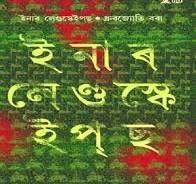The fiction Inner Landscapes by Dr Dhrubajyoti Borah is a meta-fiction in the sense that the fourth chapter of the novel indicates what a postmodern fiction should be. The fiction comments on the nature of postmodern fiction in the beginning permeating readers to scrutinise whether the fiction has followed its own presumption. A meta-narrative is a prerequisite feature of postmodern writing. Imbibing the characteristics of postmodern fiction, Inner Landscapes is both a comment on the factual reports on the history of Maan Invasion and an imaginative or fictional presentation of a story of a few characters.
Fourth chapter becomes significant as it sets forth the fiction as an experimental one. This chapter claims that a fiction like this self-consciously focuses on the form rather than the content. In a way, the form is the medium. One analytical narrative of Maan invasion and the other one of the survival story of common people perpetuate simultaneously to challenge the meta-narrative of historicity. Another way that the novel challenges the grand narrative is when the narrator doubts about the fixity of his own narrative.
The linearity of the narrative gets disrupted by the frequent allusions to the authors of world literature. The character ‘Koka’ brings in the dialogues of Shakespearean hero many a time adding to the collage-like narratorial ambience. T.S Eliot’s The Wasteland famously ends with a reference to “Om Shanti.” Borah’s Inner Landscapes resonates the same by alluding to “Om Kandat Kandat Prarohanti” in the conclusive chapter.
The novel searches for an alternative reality to history and also poses questions to the possibility of representing fictional characters as the part and parcel of history or as the historical reality itself. Such an attempt does not put an end with concluding remarks to the discussion of the novel. On the contrary, it settles for an end with no closure. The open ended closure provokes reader for the thoughtfulness of analysing history rather than accepting historical data without scrutiny as an ultimate reality.
While dealing with the perplexes of imagined reality, the novel reminds one the notions of “historicity of text” and “textuality of history” of New Historicism. It means that a history itself can be either a text or a a bearer of a text as context. In Inner Landscapes, discussions of the group on history reflects history itself as a text and the story of Brindabani, Jotadhari and their group unfolds history as the context of a text.
Dr Borah succeeds not only in contemplating history from a variety of viewpoints but also in insisting readers to survey history. His Azar is one more such comprehension which he also brings in as reference in the narrative of Inner Landscapes.
